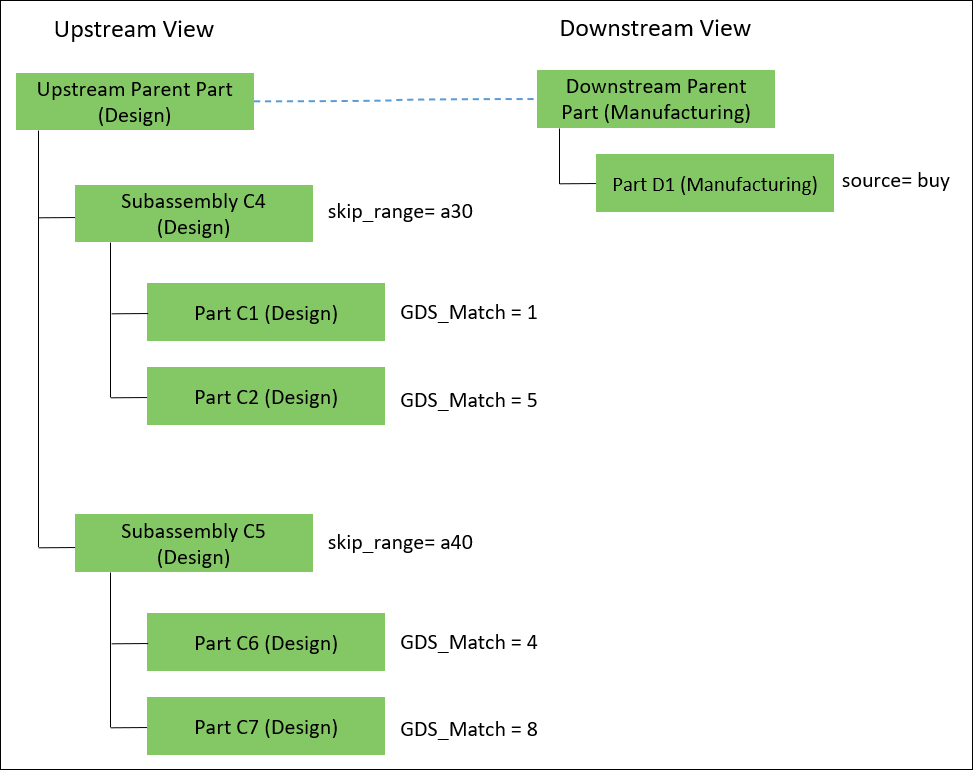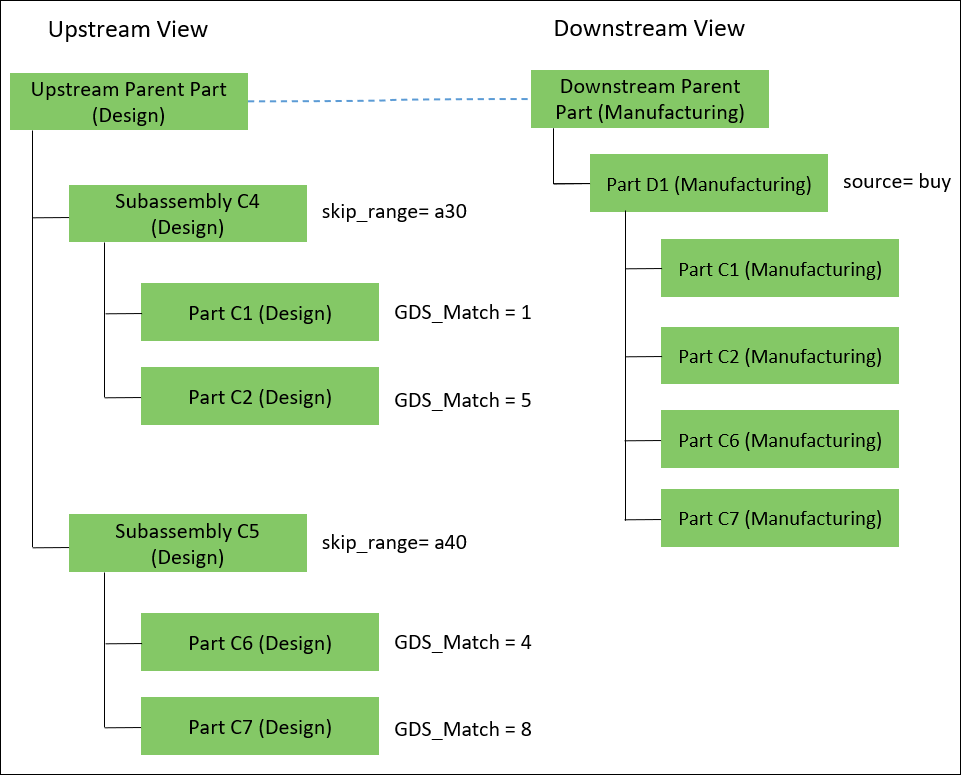使用案例 13:透過根據範圍屬性略過零件來產生下游結構
您可以透過定義範圍來產生下游結構。在某些情況下,您可能不想傳輸屬性值在特定範圍內的零件。則可以使用略過屬性來略過屬性值在特定範圍內的此類零件。
假設 BOM 轉換器中存在以下結構:

• Upstream Parent Part (Design) 與 Downstream Parent Part (Manufacturing) 之間存在對等連結。
• 結構中所有零件的零件類型均為 wt.part.WTPart。
• 偏好設定「用於定義範圍的分隔符號」的值設定為 >。此為預設值。
• 屬性 GDS_Match 建立在 WTPart 中。使用此屬性可定義範圍。
• 屬性 skip_range 建立在 WTPart 中。使用此屬性可略過零件。
• Part D1 (Manufacturing) 的屬性 source 的值設定為 buy。
1. 存取位於 Windchill/codebase/com/ptc/core/foundation/associativity 中的 associativity.properties.xconf 檔案。
2. 新增下列重新建構規則:
<Property name="com.ptc.windchill.associativity.reconciliation.addusage.wt.part.WTPart" multivalued="," default=""/>
<AddToProperty name="com.ptc.windchill.associativity.reconciliation.addusage.wt.part.WTPart" value="transformoption=newBranch"/>
<AddToProperty name="com.ptc.windchill.associativity.reconciliation.addusage.wt.part.WTPart" value="targetType=wt.part.WTPart"/>
<AddToProperty name="com.ptc.windchill.associativity.reconciliation.addusage.wt.part.WTPart" value="attributeMapping.rule1=GDS_Match:1>9:source:buy"/>
在上述內容中,1>9 描述範圍。偏好設定「用於定義範圍的分隔符號」的值設定為 >。1>9 表示範圍從 1 到 9。在此情況下,系統會考慮下列值進行比較:1、2、3、4、5、6、7、8 與 9。
<AddToProperty name="com.ptc.windchill.associativity.reconciliation.addusage.wt.part.WTPart" value="skipAttribute.skip_range=a20>a90"/>
在上述內容中,a20>a90 描述範圍。偏好設定「用於定義範圍的分隔符號」的值設定為 >。a20>a90 表示範圍從 a20 到 a90。
針對上游中的所選零件啟動  動作後,Windchill 系統會遍歷所選零件下方的結構。此組態可確保下列情況: 動作後,Windchill 系統會遍歷所選零件下方的結構。此組態可確保下列情況:• 如果上游零件的屬性 GDS_Match 的值為從 1 到 9,則會將上游零件新增為目標相符下游零件下的新分支。 • 如果 Windchill 系統偵測到上游中的零件,且其屬性 skip_range 值設定為從 a20 到 a90,則此零件會被略過,且不會在下游新增。但是,會遍歷偵測到的零件之下的結構。 |
3. 選取 Upstream Parent Part (Design),然後按一下中間窗格工具列中的  。
。
 。
。4. 下列結構會顯示在 BOM 轉換器中:

根據在內容中指定的條件,會將 Part C1 (Manufacturing)、Part C2 (Manufacturing)、Part C6 (Manufacturing)、Part C7 (Manufacturing) 新增為 Part D1 (Manufacturing) 下的新零件。 Subassembly C4 與 Subassembly C5 會被跳過且不會傳輸至下游檢視,因為 skip_range 屬性的值介於指定範圍 (即 a20>a90) 之間。 |